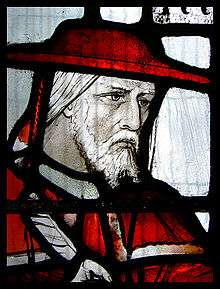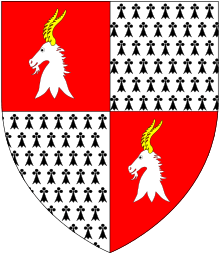John Morton (cardinal)
John Morton (c. 1420 – 15 September 1500) was an English prelate who served as Archbishop of Canterbury from 1486 until his death and also Lord Chancellor of England from 1487. He was elevated to the cardinalate in 1493.[1]
John Morton | |
|---|---|
| Cardinal, Archbishop of Canterbury Primate of All England | |
 | |
| Appointed | 6 October 1486 |
| Term ended | 15 September 1500 |
| Predecessor | Thomas Bourchier |
| Successor | Thomas Langton (as bishop-elect), Henry Deane as true Archbishop |
| Orders | |
| Consecration | 31 January 1479 |
| Created cardinal | 20 September 1493 |
| Rank | Cardinal priest of Santa Anastasia |
| Personal details | |
| Born | c. 1420 Dorset, England |
| Died | 15 September 1500 (aged c. 79/80) Knole House, near Sevenoaks, Kent, England |
| Buried | Crypt of Canterbury Cathedral |
| Nationality | English |
| Denomination | Roman Catholic |
| Previous post | Bishop of Ely, 1479–1486 |
| Education | Balliol College, Oxford |
| Coat of arms |  |
Life
Born at Milborne St Andrew in Dorset,[2] he was probably educated at Balliol College, Oxford. After graduating with a BCL in 1448, he practised law in ecclesiastical courts, including the Court of Arches, being appointed rector of Shellingford (Berkshire) in 1453. He was made prebendary of Sarum in 1458, rector of St. Dunstan's (in the West), archdeacon of Norwich circa 1460. He became a government lawyer with the Lancastrian party and drafted the Bill of Attainder against Richard, Duke of York in 1459. He was captured after the Battle of Towton and attainted, but escaped into exile, joining Queen Margaret in France, where he was Keeper of the Privy Seal to Henry VI in the Lancastrian government in exile and graduated in theology from the University of Louvain in 1469.
He returned to England in 1470, but following the failure of the Readeption and the murder of Henry VI, he made his peace with Edward IV. He received a royal pardon in July 1471, and became a Master of Chancery that Michaelmas, and Master of the Rolls in the following March. Further church appointments followed, as Archdeacon of Winchester and Dean of the Court of Arches in 1474, canon of Wells from 1475 to 1478, archdeacon of Berkshire in 1476 and archdeacon of Norfolk in 1477.[3][4] He was appointed Master of the Rolls from 1472 to 1479.
In February 1477, he was sent by the Yorkist King Edward IV, together with Sir John Donne, as ambassador to the French court. After serving a short spell in 1478 as Archdeacon of Leicester he was appointed Bishop of Ely by King Edward on 8 August 1478 and he was consecrated on 31 January 1479.[5]
Between 1478 and 1483 he had replaced the bishop's palace on the site of Wisbech Castle with one built in brick and Ketton stone. He was also responsible for cutting of 'Morton's Leam' from Stanground to Guyhirn improving the navigation and drainage of the Fens.[6]
Morton was an important foe of the Yorkist regime of King Richard III and spent some time in captivity in Brecknock Castle. After the dynastic change to the Tudors in 1485, King Henry VII made him Archbishop of Canterbury on 6 October 1486,[7] and appointed him Lord Chancellor of England in 1487.[8] In 1493 he was appointed Cardinal priest of the church of St. Anastasia in Rome by Pope Alexander VI.
In 1485 he built the residence of Ely's Bishop, which later became "Old Palace" of Hatfield Palace, on the ancestral soil of a residence of Ely's Bishops. This manor was chosen by Henry VIII, to be the nursery of his children, the place where, notably, Queen Elizabeth I spent much of her girlhood.
As Lord Chancellor, Morton was tasked with restoring the royal estate, depleted by Edward IV. By the end of Henry VII's reign, the king's frugality, and Morton's tax policy, carried out by Edmund Dudley and Richard Empson, had replenished the treasury. Morton gave a statement, later known as 'Morton's Fork', that no one was to be exempted from taxes: "If the subject is seen to live frugally, tell him because he is clearly a money saver of great ability, he can afford to give generously to the King. If, however, the subject lives a life of great extravagance, tell him he, too, can afford to give largely, the proof of his opulence being evident in his expenditure."
Morton died at Knole House, Kent, on 15 September 1500.[7] His monument was placed in the south-east part of Canterbury Cathedral's crypt, with an effigy and an arch decorated with angels, cardinal's caps, and tun barrels inscribed with MOR (a pun on his name, Mor-ton).[9] However, this monument is a cenotaph since his actual body was buried in the crypt's central chapel of the Virgin Mary, according to his wishes.
Morton, More, and the history of Richard III
Thomas More served as a page in Morton's house from the age of twelve to fourteen.[10] Morton then sent him to study at Oxford University, but More's father was adamant that his son should go on to study law and about two years later, he returned to London.[11] More later expressed his admiration of Morton by casting him in the role of the philosopher-prince in the book Utopia.[11] Morton was also one of More's sources for his History of King Richard III.[12] Some attempts to clear Richard's name of the murder of Edward V and his brother Richard, Duke of York and other crimes attributed to him in this work argue that Morton, who fled overseas and plotted against Richard after the former had escaped from custody in 1483, wrote the work or fed the material to More, who was only seven when Richard III was killed at the Battle of Bosworth Field and so had no firsthand in-depth information to work on. However, More had access to many other primary sources including his father (a practicing lawyer in London at the time and later a senior judge), Archbishop Thomas Rotherham and Thomas Howard, 2nd Duke of Norfolk.[12]
Armorials

_(14755724696).jpg)
James Bentham wrote in 1771 concerning the arms of Bishop Morton:[13][14]
"The Arms given him in Anglia Sacra, p. 673, are not sufficiently explicit; they should be thus blasoned: Quarterly gules and ermine on the 1st and 4th a goat's head erased argent. And this agrees with his arms carved various times on the noble Tower of Wisbeche Church, and as they were formerly in a window of Linton Church in Cambridgeshire, as I have it in a manuscript of church notes taken above a century ago. However these accord not with those for our bishop in his own cathedral twice, viz. in the east window of the north aisle of the presbytery, and in another window of the same aisle, where they are still remaining, and are thus blasoned: Quarterly gules and ermine, on the 1st and 4th three goat's heads erased argent, attired or.
In popular culture
In the 1972 BBC television series The Shadow of the Tower, which focused on the reign of Henry VII, Morton was played by Denis Carey.[15] In the Netflix/Canal series Borgia, Morton appears in one scene in season 2, episode 4, and is portrayed by David Gant. In the Starz miniseries The White Princess, Morton is portrayed by Kenneth Cranham.
Citations
- Miranda, Salvador. "John Morton". The Cardinals of the Holy Roman Church. Retrieved 8 October 2010.
- "Cardinal Morton ... was born ... at Milborne Syleham": Betjeman, John, ed. (1968) Collins Pocket Guide to English Parish Churches; the South. London: Collins; p. 172
- "Alumni Oxonienses 1500–1714". British History Online. Retrieved 29 May 2012.
- Christopher Harper-Bill, ‘Morton, John (d. 1500)’, Oxford Dictionary of National Biography, Oxford University Press, 2004 accessed 26 May 2017
- Fryde, et al. Handbook of British Chronology p. 245
- George Anniss (1977). A History of Wisbech Castle. EARO.
- Fryde, et al. Handbook of British Chronology p. 234
- Fryde, et al. Handbook of British Chronology p. 88
- Find a Grave: John Morton
- Weir, Alison The Princes in the Tower Pimlico London (1982) p.10
- Guy, John Thomas More Arnold London (2000) p.23
- Weir, Alison The Princes in the Tower Pimlico London (1982) p.103
- Bentham, Rev. James, The History and Antiquities of the Conventual Cathedral Church of Ely, 2nd. Edition, Cambridge, 1771,pp.46–50
- Also blazoned in Lambeth MS 555
- "The Shadow of the Tower". IMDB. Retrieved 26 June 2016.
References
- Fryde, E. B.; Greenway, D. E.; Porter, S.; Roy, I. (1996). Handbook of British Chronology (Third revised ed.). Cambridge: Cambridge University Press. ISBN 0-521-56350-X.
| Political offices | ||
|---|---|---|
| Preceded by John Alcock |
Lord Chancellor 1487–1500 |
Succeeded by Henry Deane (Keeper of the Great Seal) |
| Catholic Church titles | ||
| Preceded by William Grey |
Bishop of Ely 1478–1486 |
Succeeded by John Alcock |
| Preceded by Thomas Bourchier |
Archbishop of Canterbury 1486–1500 |
Succeeded by Thomas Langton |
| Preceded by Antonio Pallavicini Gentili |
Cardinal priest of Santa Anastasia 1493–1500 |
Succeeded by Antonio Trivulzio |
| Academic offices | ||
| Preceded by John Russell |
Chancellor of the University of Oxford 1494–1500 |
Succeeded by William Smyth |
| Wikimedia Commons has media related to John Morton (cardinal). |